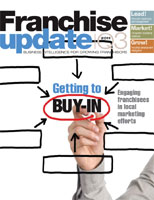Putting Sacred Cows Out to Pasture
Having survived five decades, including eight recessions, a bankruptcy, the closing of nearly half its restaurants, a reputation-killing E. coli outbreak, and multiple ownership changes, Sizzler, the original "American Family Steakhouse," was on the mend as it celebrated its 50th anniversary in January 2008.
Prospects for the venerable steakhouse were good, very good in fact. For the first time in years, the executive suite was stable. Having evolved from a failed buffet concept, Sizzler was now successfully competing in the casual dining segment against the likes of Olive Garden and Applebee's. Sales and profits were strong. Existing franchisees were making money and investing in remodels and new restaurants, and new franchisees were enthusiastically signing on and entering the system.
To say things quickly cooled off for Sizzler would be an understatement. Suddenly, gasoline prices spiked, hitting Sizzler's middle-class guests right in their dining wallets. To make matters worse, California--where the majority of Sizzler restaurants are located--experienced the nation's highest price run-ups. Sizzler's beloved CEO, on the job for seven years, was recruited to run another casual dining chain. The Australian equity group that owned the brand announced Sizzler was for sale. Next came California's housing crisis, followed by the full-blown nationwide recession.
Restaurant industry analysts predicted the massively overbuilt casual dining industry would lose thousands of units and that some well-known brands would altogether disappear from America's street corners and strip malls.
Faced with declining sales, increased costs, bad debt, and unprecedented competition from far larger chains (some spending in excess of $250 million in advertising), Sizzler's future was uncertain. To make matters worse, many franchisees were falling behind on royalty and advertising co-op payments--the lifeblood of any franchise system.
With a depression potentially brewing and nationwide de-consumerism on the rise, some within the Sizzler USA system wondered if the brand could survive yet another blow. If it were to be saved, every aspect of the 50-year-old business would need to be transformed and retooled--and fast.
Saving Sizzler USA:
Seven lessons from deconstructing and rebuilding an American icon
The first eight months of 2008 brought continuous sales declines--some as much as 20 percent compared with the previous year. We had to apply the defibrillator paddles to the brand's heart and enter the age of re-consumerism.
The shock treatment worked. After those 8 months, Sizzler's California restaurants experienced their first sales increases. Since then, Sizzler USA has posted continuous sales increases, some in double digits, with only a single month exception. During the same period, the restaurant industry as a whole suffered consistent monthly sales declines of as much as 15 percent, according to Knapp-Track, a widely watched restaurant sales and guest count report.
The multi-million dollar question
The effort to save Sizzler began in June 2008 with the arrival of a new president and CEO, Kerry Kramp, a highly regarded restaurant executive and strategist. His priorities focused on long-term investment and brand stability, and on spending the necessary human and financial resources. In the first two days of his new assignment, everything revolved around two basic questions: 1) What will drive sales? and 2) What will it take to improve profitability? This was a dramatic shift from the past, with previous Sizzler management known for running a very lean operation, with cost controls the only priority.
We also challenged ourselves to pursue "You're crazy, you can't do that" ideas. Once somebody said, "You're crazy, we can't do that," we went on a mission to explore the idea and prove to everyone that we could. In fact, one of those "crazy" ideas was the bundling of Sizzler's Endless Salad Bar (a value accelerator) with an entrée for $9.99 (it previously sold as a $3.99 add-on). This action is credited with significantly turning around the company's ailing sales. When first proposed, the idea was deemed too expensive and many thought the franchisees would never go for it.
Sizzler's transformation was a "ground-up restoration," a car collector term for taking a beloved classic apart piece by piece and putting it back together, making it better than new. But as any mechanic will tell you, putting something back together is much harder than taking it apart. Here are seven lessons Sizzler learned while deconstructing and reassembling an American icon--lessons that can apply to virtually any business.
1) Put the right team in place, right away. Despite numerous ownership and leadership changes over the years, the Sizzler home office staff included a number of longtime managers, including some who resisted Kramp's ideas. "That's how we do it here," was an all-too-common chorus. Initially, I was among the naysayers--there was somebody new playing in my sandbox!
Some members of the management team were retained, some reassigned, and others replaced. This was a major shakeup for a group of people who had been together for a long time, but change is imminent with a new leader at the top. Kerry understood and identified talent quickly and, most important, knew how the chemistry of this new talent would be a major force in the quick reconstruction of a major brand.
2) Look back and to the future, but understand the current marketplace. Sizzler had taken many twists and turns during its five decades. The new management team studied the past--even examining the last 30 years of recipes--looking for clues to the brand's core success and longevity. Yet, the environment in 2008 was far different from any experienced before. In a way, we were a 50-year-old brand starting from scratch. Sizzler's best chance for survival required a step back to a simpler menu with fewer items, more freshly prepared food, greater focus on its popular salad bar, and prices that would resonate with cash-strapped, middle-class guests. The brand's successful new market position: Sizzler understands its guests' pain and delivers the undeniably best steak, seafood, and salad bar value. In other words, "We get it!"
3) Force change. Like most franchisors, Sizzler historically relied on input and buy-in from franchisees, using franchise advisory committees that met on product development, marketing, advertising, purchasing, remodels, and other topics. But given the brand's declining sales and need for a rapid transformation, management put democracy on hold. We went to the system and said, "This is what we are going to do and, specifically, why."
4) Simplify and consolidate. A few years ago, Helen Johnson, who founded Sizzler with her husband Del more than 50 years ago, commented, "They've got too much on the menu these days. There's too much going on in the kitchen. They've gotten away from the original Sizzler concept." She was right. As part of the transformation, Sizzler removed nearly a quarter of its products, worked to improve the quality of those it kept on the menu, and streamlined kitchen operations. Extra emphasis also was put on Sizzler's salad bar, its core value accelerator.
5) Send sacred cows out to pasture. A proud, 50-year history comes with more than a few sacred cows, some of which needed to be put out to pasture, no matter how difficult. Sizzler had long given franchisees a great deal of menu flexibility, which resulted in wide variations in food quality, national distribution problems, and confusion among guests. We had to get everyone on the same menu, and that was not easy. Then came changes to how Sizzler's storied Cheese Toast was prepared, and if the Malibu Chicken, Bleu Cheese Dressing, Seafood Salad, steaks, etc., etc. were viable for today's consumers. These were all core staple items Sizzler consumers had enjoyed for decades. This put the franchise community into a tailspin and created a firestorm. We have a large franchise system, with some of our owners around for 40 years, and this added fuel to the already fragile community who liked things just the way they were.
6) Fire bad customers. Sizzler took a firm stand with franchisees who were not paying royalties or upholding brand standards. In some cases, franchisees lost the right to operate as a Sizzler. When you are turning around a brand, you need to support the franchisees who want to be part of it moving forward. It's not fair to allow a small number of poor franchisees to drag down the entire system. Today, Sizzler numbers fewer restaurants, but a stronger financial position leaves it better prepared to grow as the economy continues to rebound.
7) Beware of blind euphoria. Restaurant chains live and die by daily sales data, delivered fresh every morning. Even when sales go up, make sure you truly understand what's really happening underneath the numbers. Challenge everything.
Sizzler opened its first restaurant amid the 1958 recession. With a restaurant chain, one spoke out of true makes the wheel wobble. Decades later, after examining every aspect of the company's operations, fixing what was broken and saving what was not, Sizzler's spokes are now properly aligned, and the luster has returned to this great American icon.
Michael Branigan joined Sizzler USA in January 2004 as vice president of marketing. Before that, he served as chief marketing officer of bd's Mongolian Grill; director of operations at RPR Co.; vice president of marketing at Spectrum Restaurant Group; and vice president of marketing at Damon's International. He also has held executive-level marketing positions at Hooters of America, Carl's Jr. (CKE) Restaurants, and American Restaurant Group.
Share this Feature
Recommended Reading:
FRANCHISE TOPICS
- Multi-Unit Franchising
- Get Started in Franchising
- Franchise Growth
- Franchise Operations
- Open New Units
- Franchise Leadership
- Franchise Marketing
- Technology
- Franchise Law
- Franchise Awards
- Franchise Rankings
- Franchise Trends
- Franchise Development
- Featured Franchise Stories
FEATURED IN

Franchise Update Magazine: Issue 3, 2011








 The franchise listed above are not related to or endorsed by Franchise Update or Franchise Update Media Group. We are not engaged in, supporting, or endorsing any specific franchise, business opportunity, company or individual. No statement in this site is to be construed as a recommendation. We encourage prospective franchise buyers to perform extensive due diligence when considering a franchise opportunity.
The franchise listed above are not related to or endorsed by Franchise Update or Franchise Update Media Group. We are not engaged in, supporting, or endorsing any specific franchise, business opportunity, company or individual. No statement in this site is to be construed as a recommendation. We encourage prospective franchise buyers to perform extensive due diligence when considering a franchise opportunity.